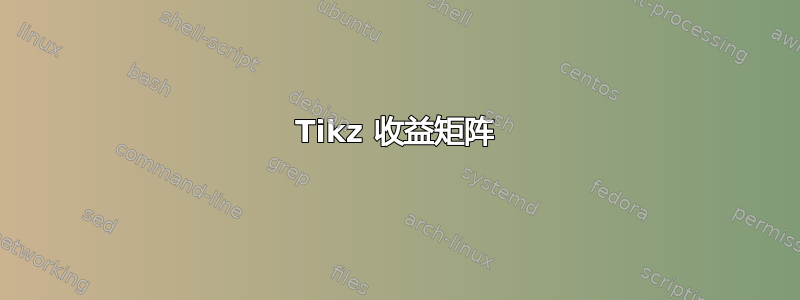
我正在尝试完全移除底部两行(C 和 D),以便创建一个 2*4 的收益矩阵。除此之外,我还想在移除“玩家 2”后将其稍微向上移动(大约在 A 和 B 之间)。我不知道该怎么做,想知道是否有人可以帮忙?
我希望它看起来或多或少是这样的(“玩家 2” 重新定位到 A 和 B 的中间):
\documentclass[12pt]{article}
\usepackage{tikz}
\usetikzlibrary{calc}
\usetikzlibrary{matrix}
\usetikzlibrary{positioning}
\usepackage{natbib}
\begin{document}
\begin{center}\begin{tikzpicture}
\def\myrowhead{{"T","F","G","T"}}
\def\mycolhead{{"A","B","C","D"}}
\matrix[matrix of math nodes,draw,
every odd row/.style={align=right},every evenrow/.style={align=left},
nodes={text width=1.5cm},row sep=0.2cm,column sep=0.2cm]
(m) {2&3&6&5\\12&2&9&9\\-1&0&0&2\\0&0&0&3\\2&3&6&1\\4&2&-1&8\\4&2&4&8\\4&2&-1&7\\};
\foreach\x[count=\xi from 2,evaluate={\xx=int(2*\x);\xxi=int(\xx+1)}] in {1,2,3}{
\draw ({$(m-1-\x)!0.5!(m-1-\xi)$}|-m.north) -- ({$(m-1-\x)!0.5!(m-1-\xi)$}|-m.south);
\draw ({$(m-\xx-1)!0.5!(m-\xxi-1)$}-|m.west) -- ({$(m-\xx-1)!0.5!(m-\xxi-1)$}-|m.east);
}
\foreach\x in{0,1,2,3}{
\node[text depth=0.25ex,above=2mm] at ($(m.north west)!{(2*\x+1)/8}!(m.north east)$)
{\pgfmathparse{\myrowhead[\x]}\pgfmathresult};
\node[left=2mm] at ($(m.north west)!{(2*\x+1)/8}!(m.south west)$)
{\pgfmathparse{\mycolhead[\x]}\pgfmathresult};
}
\node[above=18pt of m.north] (firm b) {Player 1};
\node[left=1.6cm of m.west,align=center,anchor=center] {Player 2};
\end{tikzpicture}
\end{center}
\end{document}
答案1
我尝试保留您提供的代码框架。我可能更改的唯一内容是其中的两个空条目\def\mycolhead{{"A","B","",""}}(但它很好地完成了工作 :))。
较新的答案:
\documentclass[12pt]{article}
\usepackage{tikz}
\usetikzlibrary{calc}
\usetikzlibrary{matrix}
\usetikzlibrary{positioning}
\usepackage{natbib}
\begin{document}
\begin{center}\begin{tikzpicture}
\def\myrowhead{{"T","F","G","T"}}
\def\mycolhead{{"A","B","",""}}
\matrix[matrix of math nodes,
draw, every odd row/.style={align=right},
every evenrow/.style={align=left},
nodes={text width=1.5cm},
row sep=0.2cm,column sep=0.2cm]
(m) {
2&3&6&5\\
12&2&9&9\\
-1&0&0&2\\
0&0&0&3\\
};
% Horizontal line
\draw ({$(m-2-1)!0.5!(m-3-1)$}-|m.west) -- ({$(m-2-1)!0.5!(m-3-1)$}-|m.east);
% Vertical lines
\foreach\x[count=\xi from 2,evaluate={\xx=int(2*\x);\xxi=int(\xx+1)}] in {1,...,3}{
\draw ({$(m-1-\x)!0.5!(m-1-\xi)$}|-m.north) -- ({$(m-1-\x)!0.5!(m-1-\xi)$}|-m.south);
}
\foreach\x in{0,1,2,3}{
\node[text depth=0.25ex,above=2mm] at ($(m.north west)!{(2*\x+1)/8}!(m.north east)$)
{\pgfmathparse{\myrowhead[\x]}\pgfmathresult};
\node[left=2mm] at ($(m.north west)!{(2*\x+1)/4}!(m.south west)$)
{\pgfmathparse{\mycolhead[\x]}\pgfmathresult};
}
\node[above=18pt of m.north] (firm b) {Player 1};
\node[left=1.6cm of m.west,align=center,anchor=center] {Player 2};
\end{tikzpicture}
\end{center}
\end{document}
上一个答案:
\documentclass[12pt]{article}
\usepackage{tikz}
\usetikzlibrary{calc}
\usetikzlibrary{matrix}
\usetikzlibrary{positioning}
\usepackage{natbib}
\begin{document}
\begin{center}\begin{tikzpicture}
\def\myrowhead{{"T","F","G","T"}}
\def\mycolhead{{"A","B","",""}}
\matrix[matrix of math nodes,
draw, every odd row/.style={align=right},
every evenrow/.style={align=left},
nodes={text width=1.5cm},
row sep=0.2cm,column sep=0.2cm]
(m){
2&3&6&5\\
12&2&9&9\\
-1&0&0&2\\
0&0&0&3\\
};
\foreach\x[count=\xi from 2,evaluate={\xx=int(2*\x);\xxi=int(\xx+1)}] in {1}{
\draw ({$(m-1-\x)!0.5!(m-1-\xi)$}|-m.north) -- ({$(m-1-\x)!0.5!(m-1-\xi)$}|-m.south);
\draw ({$(m-\xx-1)!0.5!(m-\xxi-1)$}-|m.west) -- ({$(m-\xx-1)!0.5!(m-\xxi-1)$}-|m.east);
}
\foreach\x in{0,1,2,3}{
\node[text depth=0.25ex,above=2mm] at ($(m.north west)!{(2*\x+1)/8}!(m.north east)$)
{\pgfmathparse{\myrowhead[\x]}\pgfmathresult};
\node[left=2mm] at ($(m.north west)!{(2*\x+1)/4}!(m.south west)$)
{\pgfmathparse{\mycolhead[\x]}\pgfmathresult};
}
\node[above=18pt of m.north] (firm b) {Player 1};
\node[left=1.6cm of m.west,align=center,anchor=center] {Player 2};
\end{tikzpicture}
\end{center}
\end{document}
答案2
只是为了证明你不需要 Ti钾Z 矩阵来绘制你的表格,一些嵌套的tabular就足够了。
为了方便起见,我使用了一个宏来处理几个收益,就像 marmot 的回答一样。
\documentclass[12pt]{article}
\usepackage{array}
\newcolumntype{C}[1]{>{\centering\arraybackslash}p{#1}}
\newcommand{\pft}[2]{\begin{tabular}{@{}C{1em}@{\hspace{1.5em}}C{1em}@{}} \rule{0pt}{3ex} & #1 \\[1ex] #2 & \\[1ex] \end{tabular}}
\newcommand{\myh}[2]{\multicolumn{1}{C{#1}}{#2}}
\begin{document}
\begin{center}
\begin{tabular}{c@{}C{1.5em}|*4{C{4em}}}
& \myh{1.5em}{} & \multicolumn{4}{c}{Player 1} \\[1ex]
& \myh{1.5em}{} & \myh{4em}{T} & \myh{4em}{F} & \myh{4em}{G} & \myh{4em}{T} \\[1ex]
Player 2 &
\multicolumn{5}{c}{%
\begin{tabular}{@{}C{1.5em}|*4{C{4em}|}@{}}
\cline{2-5}
A & \pft{2}{12} & \pft{3}{2} & \pft{6}{9} & \pft{5}{9} \\
\cline{2-5}
B & \pft{-1}{0} & \pft{0}{0} & \pft{0}{0} & \pft{2}{3} \\
\cline{2-5}
\end{tabular}}
\end{tabular}
\end{center}
\end{document}
如果您喜欢“玩家 2”旋转,您可以使用带有正确对齐选项的\rotatebox包:graphicxorigin=c
\documentclass[12pt]{article}
\usepackage{graphicx}
\usepackage{array}
\newcolumntype{C}[1]{>{\centering\arraybackslash}p{#1}}
\newcommand{\pft}[2]{\begin{tabular}{@{}C{1em}@{\hspace{1.5em}}C{1em}@{}} \rule{0pt}{3ex} & #1 \\[1ex] #2 & \\[1ex] \end{tabular}}
\newcommand{\myh}[2]{\multicolumn{1}{C{#1}}{#2}}
\begin{document}
\begin{center}
\begin{tabular}{c@{}C{1.5em}|*4{C{4em}}}
& \myh{1.5em}{} & \multicolumn{4}{c}{Player 1} \\[1ex]
& \myh{1.5em}{} & \myh{4em}{T} & \myh{4em}{F} & \myh{4em}{G} & \myh{4em}{T} \\[1ex]
\rotatebox[origin=c]{90}{Player 2} &
\multicolumn{5}{c}{%
\begin{tabular}{@{}C{1.5em}|*4{C{4em}|}@{}}
\cline{2-5}
A & \pft{2}{12} & \pft{3}{2} & \pft{6}{9} & \pft{5}{9} \\
\cline{2-5}
B & \pft{-1}{0} & \pft{0}{0} & \pft{0}{0} & \pft{2}{3} \\
\cline{2-5}
\end{tabular}}
\end{tabular}
\end{center}
\end{document}
答案3
这个答案带有一种风格payoff matrix,可以为你完成所有工作。你只需要说
\matrix [payoff matrix]{& T & F & G & T\\
A & \pft{2}{12} & \pft{3}{2} & \pft{6}{9} & \pft{5}{9} \\
B & \pft{-1}{0} & \pft{0}{0} & \pft{0}{0} & \pft{2}{3} \\
};
其中\pft有两个参数,单元格右上角和左下角的条目。球员的名字存储在 pgf 键中,因此您可以轻松更改它们。
\documentclass[tikz,border=3.14mm]{standalone}
\usetikzlibrary{matrix}
\tikzset{payoff matrix/.style={matrix of nodes,column sep=-\pgflinewidth,row sep=-\pgflinewidth,
nodes={/utils/exec=\ifnum\the\pgfmatrixcurrentrow>1
\ifnum\the\pgfmatrixcurrentcolumn>1
\tikzset{
text height=1.2em,text width=4em,draw}
\fi
\fi,
align=center,anchor=center},
column 1/.style={text width=1em},
row 1/.style={text depth=0.3em},
execute at end matrix={%
\path (\tikzmatrixname-2-2.west) -- (\tikzmatrixname-2-\the\pgfmatrixcurrentcolumn.east)
coordinate[midway] (aux)
node[anchor=south,draw=none] at (\tikzmatrixname.north-|aux){\pgfkeysvalueof{/tikz/payoff
matrix/player 1}};
\path (\tikzmatrixname-2-2.north) --
(\tikzmatrixname-\the\pgfmatrixcurrentrow-2.south)
coordinate[midway] (aux)
node[anchor=south,draw=none,rotate=90] at (aux-|\tikzmatrixname.west){\pgfkeysvalueof{/tikz/payoff
matrix/player 2}};}},
payoff matrix/.cd,player 1/.initial={Player 1},player 2/.initial={Player 2}}
\begin{document}
\begin{tikzpicture}
\newcommand{\pft}[2]{{\hfill$#1$ \\ $#2$\hfill\mbox{}}}
\matrix [payoff matrix]{& T & F & G & T\\
A & \pft{2}{12} & \pft{3}{2} & \pft{6}{9} & \pft{5}{9} \\
B & \pft{-1}{0} & \pft{0}{0} & \pft{0}{0} & \pft{2}{3} \\
};
\end{tikzpicture}
\end{document}
这就是为什么我相信使用 Ti钾这里是 Z:添加一些功能很简单(而且Player 2旋转和居中也毫不费力)。(当然,我同意,如果你不想自由添加功能,也不想旋转Player 2,那么普通的表格就可以了。)
\documentclass[tikz,border=3.14mm]{standalone}
\usetikzlibrary{matrix}
\tikzset{payoff matrix/.style={matrix of nodes,column sep=-\pgflinewidth,row sep=-\pgflinewidth,
nodes={/utils/exec=\ifnum\the\pgfmatrixcurrentrow>1
\ifnum\the\pgfmatrixcurrentcolumn>1
\tikzset{
text height=1.2em,text width=4em,draw,
path picture={\fill[blue!20] (path picture bounding box.north west) -|
(path picture bounding box.south east);
\fill[red!20] (path picture bounding box.north west) |-
(path picture bounding box.south east);}}
\fi
\fi,
align=center,anchor=center},
column 1/.style={text width=1em},
row 1/.style={text depth=0.3em},
execute at end matrix={%
\path (\tikzmatrixname-2-2.west) -- (\tikzmatrixname-2-\the\pgfmatrixcurrentcolumn.east)
coordinate[midway] (aux)
node[anchor=south,draw=none,path picture={}] at (\tikzmatrixname.north-|aux){\pgfkeysvalueof{/tikz/payoff
matrix/player 1}};
\path (\tikzmatrixname-2-2.north) --
(\tikzmatrixname-\the\pgfmatrixcurrentrow-2.south)
coordinate[midway] (aux)
node[anchor=south,draw=none,path picture={},rotate=90] at (aux-|\tikzmatrixname.west){\pgfkeysvalueof{/tikz/payoff
matrix/player 2}};}},
payoff matrix/.cd,player 1/.initial={Player 1},player 2/.initial={Player 2}}
\begin{document}
\begin{tikzpicture}
\newcommand{\pft}[2]{{\hfill$#1$ \\ $#2$\hfill\mbox{}}}
\matrix [payoff matrix]{& T & F & G & T\\
A & \pft{2}{12} & \pft{3}{2} & \pft{6}{9} & \pft{5}{9} \\
B & \pft{-1}{0} & \pft{0}{0} & \pft{0}{0} & \pft{2}{3} \\
};
\end{tikzpicture}
\end{document}










